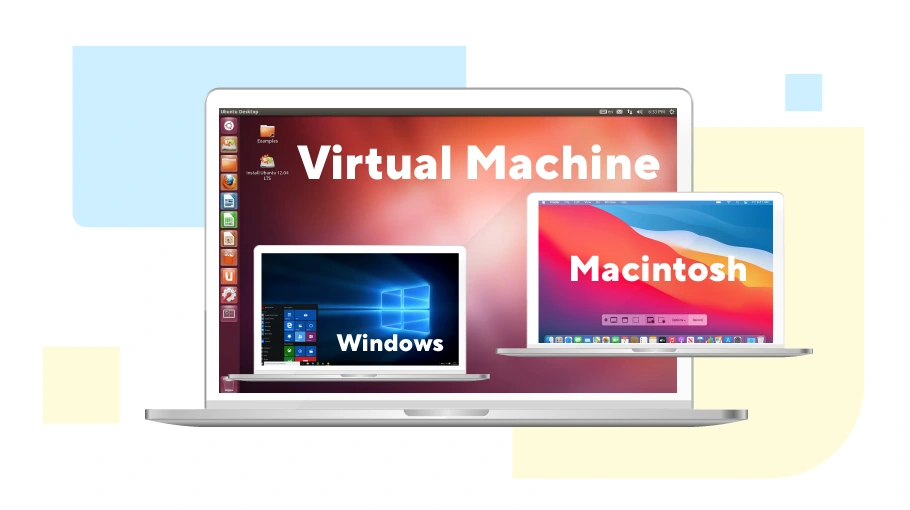the v-User Recorder Program Manual
Table of content
About the Recorder Application
The name of this application is the vUser Recorder, and its icon looks like a red hand (). This application is used to record mouse and keyboard actions, and to save them in a macro file to be later executed.
The general workflow of recording a Macro is like this:
First, on the main window of the Recorder application, you click on the
 button, and the recording window will appear.
Then you begin to perform the actions that you want to record.
While you perform these actions, the application records them.
Once you click on the stop stop
(
button, and the recording window will appear.
Then you begin to perform the actions that you want to record.
While you perform these actions, the application records them.
Once you click on the stop stop
(![]() ),
you can save the recorded commands in a Macro file by clicking on the
),
you can save the recorded commands in a Macro file by clicking on the
 button.
By doing this, you’ll have a file with the VUM extension that is ready to be opened by the Player application.
button.
By doing this, you’ll have a file with the VUM extension that is ready to be opened by the Player application.
The Main Window of the Recorder Application
Once you open the Recorder application, its main window is going to open, and it looks like this:

Changing the Language of the Recorder Application
The Virtual User Software is delivered in English and Persian languages.
If you want to change the language of the application, you can click on the “Setting”
(![]() )
) button, and select the language that you want from the “Language” sub-menu.
)
) button, and select the language that you want from the “Language” sub-menu.

Open Macro Button

By clicking on the
 button, you can open a previously saved Macro,
and add more commands and actions to the end of its commands.
button, you can open a previously saved Macro,
and add more commands and actions to the end of its commands.
Record New Macro

Whether a Macro has been opened or not, the
 will begin to record a new set of commands and actions.
will begin to record a new set of commands and actions.
Continue Record Button

If you have opened a Macro, or are in the middle of recording one, the
( )
button will be enabled. If you click on this button,
you can return to recording actions and commands for the current Macro.
)
button will be enabled. If you click on this button,
you can return to recording actions and commands for the current Macro.
Save Macro Button
To save the actions that have been recorded, you can click on the
 button.
button.
Save Macro Sub-Menu Button

This sub-menu works button, but if you select this item, there will be no prompts to change the name of the Macro. If there is a Macro with the same name, it will be overwritten by the Recorded Macro.
Settings Button of virtual user recorder application

By clicking on this button, you can change the language of the application and view its help files.
Changing the Language of the Recorder
The Virtual User Software is delivered in English and Persian languages.
If you want to change the language of the application, you can click on the “Setting”
(![]() )
) button, and select the language that you want from the “Language” sub-menu.
)
) button, and select the language that you want from the “Language” sub-menu.

Help Menu Item of virtual user recorder application
Clicking on this button opens the Help file of the application.

About Menu Item of virtual user recorder application
Clicking on this button opens a window that contains some information about the application.

This window looks like this
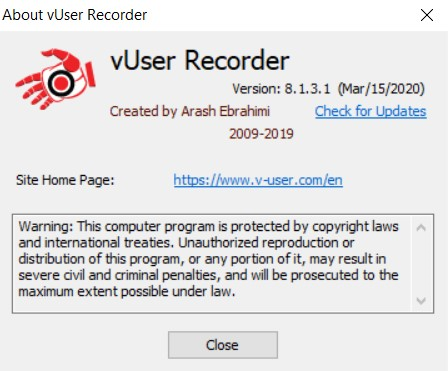
The Recorder Window of virtual user recorder application
When you click on the “Record New Macro” or “Continue Recording” buttons, the Recorder application will change its state and begins recording the action. In the recording state, the window will change and is going to look like the image below. While the Recorder is in this state, all the actions that you perform will be saved and reported in a list. In this image, you can see the first recorded command.

You can change the size of this window, and by increasing the height, you can see all the reports and actions that have been recorded so far.
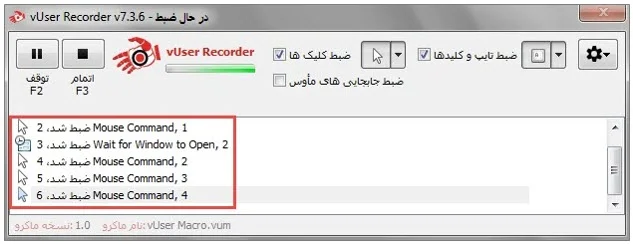
Pause Button of virtual user recorder application
While recording a Macro, all mouse and keyboard actions are recorded.
Therefore, if you want to perform an action and don’t want it to be recorded,
first, you need to click on the “pause”
(![]() )
or press the F2 key on your keyboard, then perform the actions that you want,
and finally click on the same button that now looks like this:
)
or press the F2 key on your keyboard, then perform the actions that you want,
and finally click on the same button that now looks like this:
![]() to continue to record the actions. Or, you can click on the “Stop”
(
to continue to record the actions. Or, you can click on the “Stop”
(![]() button or press the F3 key, and when you are ready to record again, click on the
button or press the F3 key, and when you are ready to record again, click on the
 button on the main window.
button on the main window.
Stop Button of virtual user recorder application
While recording a Macro, all mouse and keyboard actions are recorded.
Therefore, if you want to perform an action and don’t want it to be recorded,
first, you need to click on the “pause”
(![]() )
or press the F2 key on your keyboard, then perform the actions that you want,
and finally click on the same button that now looks like this:
)
or press the F2 key on your keyboard, then perform the actions that you want,
and finally click on the same button that now looks like this:
![]() to continue to record the actions. Or, you can click on the “Stop”
(
to continue to record the actions. Or, you can click on the “Stop”
(![]() button or press the F3 key, and when you are ready to record again, click on the
button or press the F3 key, and when you are ready to record again, click on the
 button on the main window.
button on the main window.
Configuring the Record Process

By changing these options, you can configure what gets recorded. If you uncheck these options, the actions that are performed by the corresponding devices (mouse or keyboard) will not be recorded. There are some other options which we’ll discuss in another article.
Configuring the Recording
The Recorder application has some options that you can use to configure the Recording process of mouse and keyboard commands. You can also disable the capture of mouse or keyboard actions.
In the middle of the Recorder application, there are two menus, one is for mouse, and the other is for keyboard configurations:
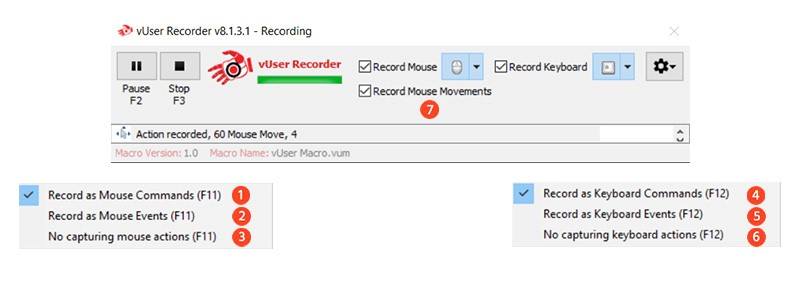
By enabling each of these options, you can configure the recording process.
![]() Record Mouse Commands (F11)
If this option is enabled, the detailed information of the
clicked window or button will also be captured. This information will
help the Player application to locate the correct window and button better while executing the macro
Record Mouse Commands (F11)
If this option is enabled, the detailed information of the
clicked window or button will also be captured. This information will
help the Player application to locate the correct window and button better while executing the macro
![]() Mouse Events (F11)
If this option is enabled, only the X & Y coordinates of the mouse will be recorded,
and the Player application will click on those coordinates, regardless of a window being there.
Mouse Events (F11)
If this option is enabled, only the X & Y coordinates of the mouse will be recorded,
and the Player application will click on those coordinates, regardless of a window being there.
![]() No Capturing mouse commands (F11)
As the name suggests, if this option is enabled, mouse commands will not be recorded.
No Capturing mouse commands (F11)
As the name suggests, if this option is enabled, mouse commands will not be recorded.
![]() Record as Keyboard Commands (F12)
If this option is enabled, detailed information on active windows and focused
text boxes will be saved along with the keyboard commands.
This information will help the Player application to run the macros
better and type the saved keyboard commands the same window and box.
Record as Keyboard Commands (F12)
If this option is enabled, detailed information on active windows and focused
text boxes will be saved along with the keyboard commands.
This information will help the Player application to run the macros
better and type the saved keyboard commands the same window and box.
![]() Record as Keyboard Events (F12)
If this option is enabled, only the pressed keys will be recorded.
When the Player application is executing Keyboard events, it just types
the keys and doesn’t care about the active windows or focused text boxes.
Record as Keyboard Events (F12)
If this option is enabled, only the pressed keys will be recorded.
When the Player application is executing Keyboard events, it just types
the keys and doesn’t care about the active windows or focused text boxes.
![]() No capturing keyboard Actions (F12)
As the name suggests, if this option is enabled, the application will not record keyboard commands
No capturing keyboard Actions (F12)
As the name suggests, if this option is enabled, the application will not record keyboard commands
![]() Mouse Movements
By enabling this option, the app will record the movements of your mouse on the screen.
Mouse Movements
By enabling this option, the app will record the movements of your mouse on the screen.
Recording Other Actions
While recording, you can use function keys to record one of these actions:
| F2 | pause | To pause the recording process | F2 |
| F3 | stop | To stop the recording process | F3 |
| F4 | Set Window to Stay on Top | Applies to the recorder window | F4 |
| F5 | Get Text from Window/Control | Gets the title of a window, or contents of a textbox | F5 |
| F6 | Set Text into Window/Control | Changing the contents of a textbox or the title of a window | F6 |
| F7 | Wait for Window to Close | Waiting for a specific window to close | F7 |
| F8 | Wait for Window to Open | Waiting for a specific window to open | F8 |
| F9 | Check Control Status | Enabled or Disabled, Visible or Hidden | F9 |
Settings Button of the Recorder
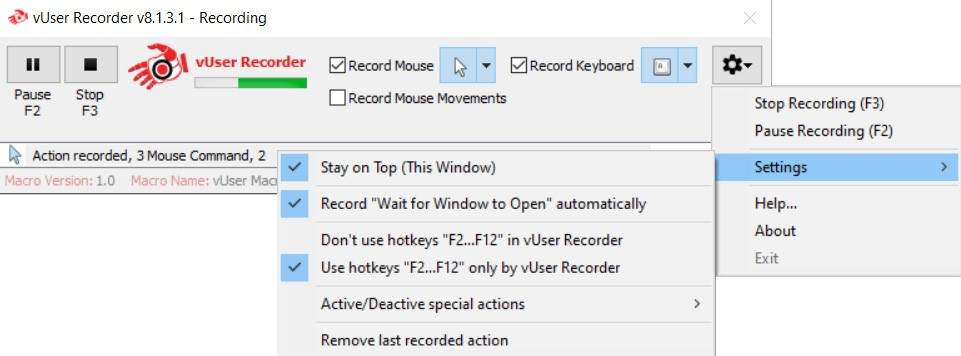
Set the window to Stay On Top
If you want the recorder window to stay on top of all other windows, you need to (first, pause the recording by pressing the F2 key, and then) by clicking on the Settings button and selecting the Settings menu, click on the Stay On Top (This Window) menu item.
Record Wait for window to open Automatically
As an example, let’s assume you have saved a Mouse Action, that clicks on the “Ok” button of a Login Window; when the macro reaches this action, what happens if the Login window hasn’t been opened yet? Naturally, the Player will not find the button and shows an error. To address this situation, you can insert a “Delay,” but in different circumstances (like, for example, when your systems become slow), you might need to set various delays. The Virtual User Software has the ability to wait for a specific window to open, and then run the next commands. So the Player can wait for the Login window to open and then click on the Ok button.
Therefore, when you are recording the actions that are performed on new windows, you need to check that this option is selected. If this is the case, each time you open a new window or application, a “Wait for Window to Open” action will be saved automatically.
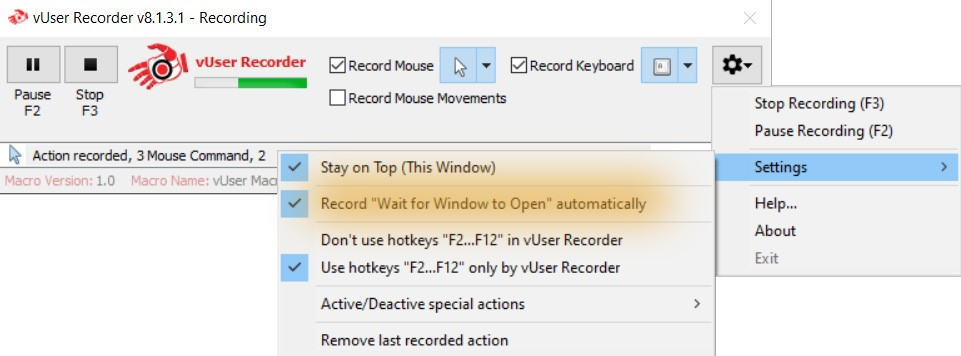
Using or Not Using the Function Keys
While the Recorder window is visible, all the function keys of your keyboard will
change to its shortcuts. This means that if you press the F3 key on any screen,
the Stop button of the Recorder application will be pressed, and the recording will stop.
However, if you do not need this functionality, you can disable it.
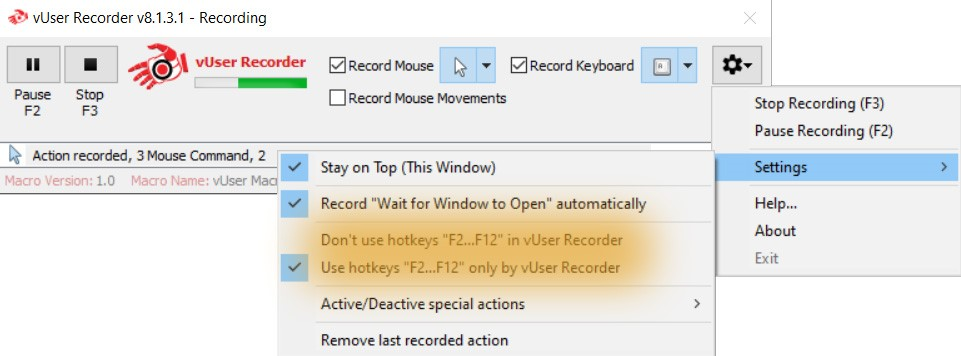
If the first option (Don’t use hotkeys ”F2 … F12” in vUser Recorder) is selected,
then the Recorder application will not bind these keys, and you can no longer use
them as shortcuts. For example, if this option is selected, and you want to stop
the recording process, you need to click on the Stop button yourself.
If the second option (Use hotkeys ”F2 … F12” in vUser Recorder)
is selected, then the Recorder application will bind these keys,
and you can no longer use them on other apps.
If none of these options are selected, then the function keys will work in both the Recorder applications and all other applications.
Actions that will not be recorded
The Recorder application will ignore some actions to make the recording process more manageable. For example:
- Mouse movements from one point to another will not be recorded, and the application just records the actions of the mouse.
- When you click on the Title Bar of a window or move it around, these actions will not be recorded. Therefore, you can move the windows to the locations that you want.
- When you use the options or buttons of the Recorder application, no action will be recorded, so you can easily work with this window during the recording process.
- If keyboard function keys are only used in the Recorder application, then pressing them will not be recorded. (you can also bind/unbind specific function keys)
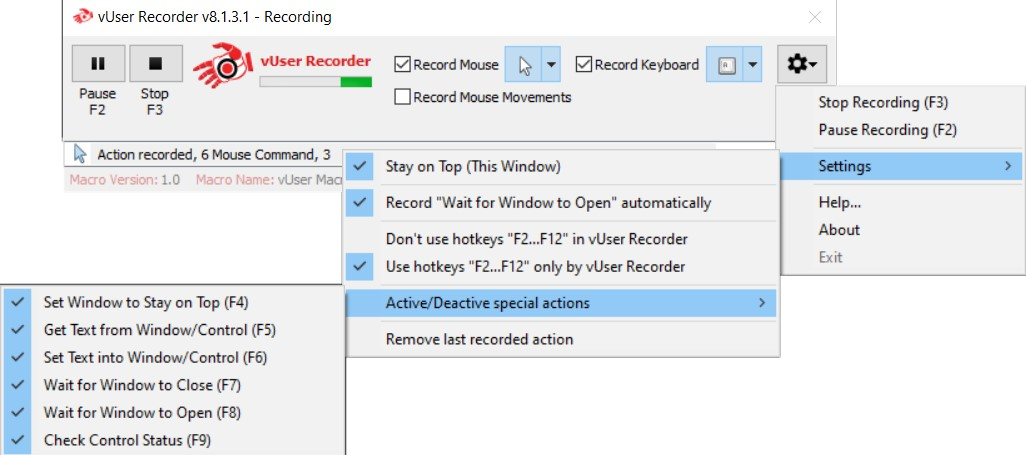
Remove Last Recorded Action
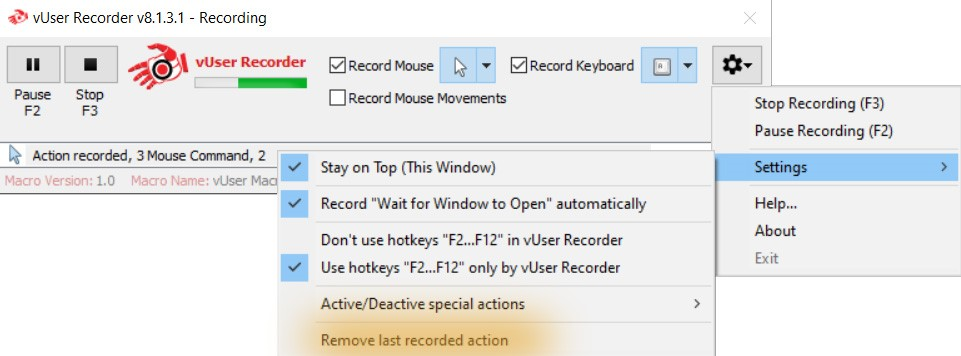
As the name suggests, you can use this menu item to remove the last command that has been recorded. When you clicked or typed something that you didn’t want to record, this option comes in handy. Note that once this is done, there is no way to recover the last action.



